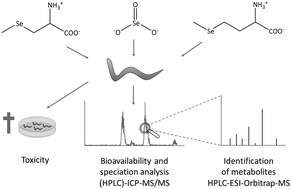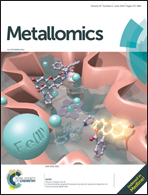Selenium species-dependent toxicity, bioavailability and metabolic transformations in Caenorhabditis elegans†
Abstract
The essential micronutrient selenium (Se) is required for various systemic functions, but its beneficial range is narrow and overexposure may result in adverse health effects. Additionally, the chemical form of the ingested selenium contributes crucially to its health effects. While small Se species play a major role in Se metabolism, their toxicological effects, bioavailability and metabolic transformations following elevated uptake are poorly understood. Utilizing the tractable invertebrate Caenorhabditis elegans allowed for an alternative approach to study species-specific characteristics of organic and inorganic Se forms in vivo, revealing remarkable species-dependent differences in the toxicity and bioavailability of selenite, selenomethionine (SeMet) and Se-methylselenocysteine (MeSeCys). An inverse relationship was found between toxicity and bioavailability of the Se species, with the organic species displaying a higher bioavailability than the inorganic form, yet being less toxic. Quantitative Se speciation analysis with HPLC/mass spectrometry revealed a partial metabolism of SeMet and MeSeCys. In SeMet exposed worms, identified metabolites were Se-adenosylselenomethionine (AdoSeMet) and Se-adenosylselenohomocysteine (AdoSeHcy), while worms exposed to MeSeCys produced Se-methylselenoglutathione (MeSeGSH) and γ-glutamyl-MeSeCys (γ-Glu-MeSeCys). Moreover, the possible role of the sole selenoprotein in the nematode, thioredoxin reductase-1 (TrxR-1), was studied comparing wildtype and trxr-1 deletion mutants. Although a lower basal Se level was detected in trxr-1 mutants, Se toxicity and bioavailability following acute exposure was indistinguishable from wildtype worms. Altogether, the current study demonstrates the suitability of C. elegans as a model for Se species dependent toxicity and metabolism, while further research is needed to elucidate TrxR-1 function in the nematode.



 Please wait while we load your content...
Please wait while we load your content...